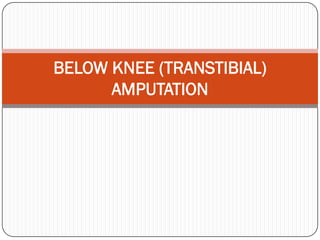
Below knee amputation
- 1. BELOW KNEE (TRANSTIBIAL) AMPUTATION
- 2. OUTLINE INTRODUCTION EPIDEMIOLOGY RELEVANT ANATOMY CLASSIFICATION INDICATIONS LEVEL OF AMPUTATION PREOPERATIVE PREPARATIONS INTRAOPERATIVE PROCEDURE
- 3. POSTOPERATIVE CARE/REHABILITATION COMPLICATIONS PROSTHESIS SITUATION IN OUR SUBREGION CONCLUSION
- 4. INTRODUCTION Amputation is the surgical removal of a limb or part of a limb by cutting through the shaft of the bone. It is the most ancient surgical procedures. Early surgical amputation was a crude procedure by which a limb was rapidly severed from an unanaesthesized patient,the open stump was crushed or dipped in boiling oil to obtain haemostasis.
- 5. Hippocrates 1st to use ligature which was lost during the dark ages. 1529:Pare reintroduced it & artery forceps. 1674:Morel introduced tourniquet. With the introduction of general anaesthesia & antiseptic technique in the late 19th century surgeons could now fashion a functional stump.
- 6. EPIDEMIOLOGY More than 300,000 patients with amputations live in the U S according to NCHS and about 65,000 amputations are performed annually. >90% of amputations performed in western world are secondary to PVDx. In younger patient trauma is the leading cause followed by malignancy. 1965, AK : BK = 70 : 30
- 7. 1980, AK : BK = 30 : 70. In FMC Owerri,41 BKA were done in the last 2years with M : F = 1.7 : 1. Diabetic foot gangrene 88%, Trauma & TBS 5% each, others 2%
- 9. CLASSIFICATION 1) Emergency or Elective. 2)Provisional or Definitive. 3)End bearing or Non end bearing.
- 10. INDICATIONS Colloquially 3 D’s Dead (or Dying) Dangerous limb Gangrene Malignant tumours Peripheral Vascular disease Osteosarcoma Atherosclerosis Marjolins ulcer Embolism Melanoma DM Potentially lethal sepsis Crush Injury Damn Nuisance Severe Trauma Pain Burns Gross malformation Frost bite Recurrent Sepsis Bone setters gangrene Severe loss of function Madura foot Elephantiasis
- 12. LEVEL OF AMPUTATION Determined by : a) Disease process b) Viability of tissues and c) Prosthesis available. Determination of adequate blood flow: Clinical : i.) lowest palpable pulse ii.)skin colour and temperature iii)bleeding at surgery Others : .Doppler ultrasonography: Ankle : brachial index > 0.5.
- 13. Compression pressure at the calf >65mmHg. Transcutaneous oxygen measurement >40mmHg. Skin perfusion pressure measurement by infrared thermography or laser doppler flowmetry. Too short a stump may tend to slip out of prosthesis. Too long a stump may have
- 14. inadequate circulation & can become painful or ulcerate.
- 15. PREOPERATIVE PREPARATION Assessment and resuscitation Investigate & address co-morbid conditions in consultation with physicians, Anaesthetists & Physiotherapist(multidisciplinary). FBC, FBS, Se/u/c, urinalysis, chest x-ray, ECG, serum albumin(>3.5g/dl). Informed consent –pathology, inevitability of amputation, complications, availability of prosthesis
- 16. Determine the level of amputation. Goal of the surgeon is to: a)Find a place where healing is mostly to be complete. b)To have an ideal stump for prosthesis fitting.
- 17. QUALITIES OF AN IDEAL STUMP 1)Should heal adequately. 2)Should have rounded, gently contour with adequate muscle padding. 3)Should have sufficient length to bear prosthesis. 4)Should have thin scar which does not interfere with prosthetic function. 5)Should have adequate adjacent joint movt.
- 18. 6)Should have adequate blood supply.
- 19. INTRAOPERATIVE PROCEDURE ANAESTHESIA : GA/Spinal POSITION : Supine PREINCISION : prophylactic antibiotics, exsanguinate, tourniquet, skin prep & draping. PROCEDURE: .An incision to outline a long posterior flap & a short anterior one --- combined length 1 ½ times the diameter of the leg at the level of amputation.
- 20. Deepened to the bone. Periosteum raised. Section tibia at level of incision, bevel anterior surface. Fibular 2-3cm proximally. Smoothen round sharp margins. Vessels isolated and double ligated,Nerves pulled down & cut with a sharp knife & allowed to retract into the soft tissue. Irrigation with N/S, Removal of tourniquet to meticulously secure haemostasis.
- 21. Myoplasty or Myodesis done over a drain after trimming the muscle to size. Close skin with interrupted non absorbable sutures. Wound dressing- soft or rigid.
- 24. POSTOP CARE/ REHABILITATION General care: Control of pain, prevention oedema, prevention of infection, DVT prevention, care of concurrent medical conditions., Suture removal. Physiotherapy: Muscles exercised, joints kept mobile, patients taught how to use crutches & prosthesis.
- 25. Stump dressing: .Soft dressing: gauze, cotton wool, bandage. Teach patient or relative stump bandaging. .Rigid dressing: POP cast can be used with stump socks & padding. A jig could be applied that allows attachment and alignment for early pylon use where limited weight bearing with BAC is possible.
- 26. Cast changed every 5-7 days for skin care. Within 3-4 wks rigid dressing can be changed to a removable temporary prosthesis. Benefits: a)prevention of oedema b)enhanced wound healing c)early maturation of stump d)decreased post op pain e)allow early ambulation f)position stump to avoid contracture
- 28. Rehabilitation of the patient is a multidisciplinary approach. Aim is to bring the patient to an optimum of physical , mental, emotional, social, vocational, & economic efficiency.
- 29. COMPLICATIONS Early Haemorrhage Haematoma Infection Late depression Stump ulceration Flap necrosis Painful scar Phantom limb Phantom pain Joint stiffness Osteomyelitis Osteoporosis & tendency to fracture
- 30. PROSTHESIS Is the substitution of a part of the body to achieve optimum function. Eg BKA prosthesis A)patellar tendon bearing B)solid ankle cushion heel Advantages: i) Cosmesis ii)Ambulation iii) Function of the part. Disadvantages: i)infection ii)pressure ulcer iii) cost
- 32. SITUATION IN OUR SUBREGION Socio-cultural belief a)re-incarnation b)Husband authority over wife c)Children never have authority d)Males usually decides Traditional bone setters Few prosthetic centers Poverty Few centers for microvascular surgeries.
- 33. CONCLUSION Amputation should be done by surgeons who have knowledge of amputation surgical principles,postop rehabilitation, & prosthetic design. Improved prosthetic design does not compensate for a poorly performed surgical procedure. Amputation should not be viewed as a failure
- 34. of treatment but rather as the 1st step towards a patient’s return to a more comfortable & productive life.
